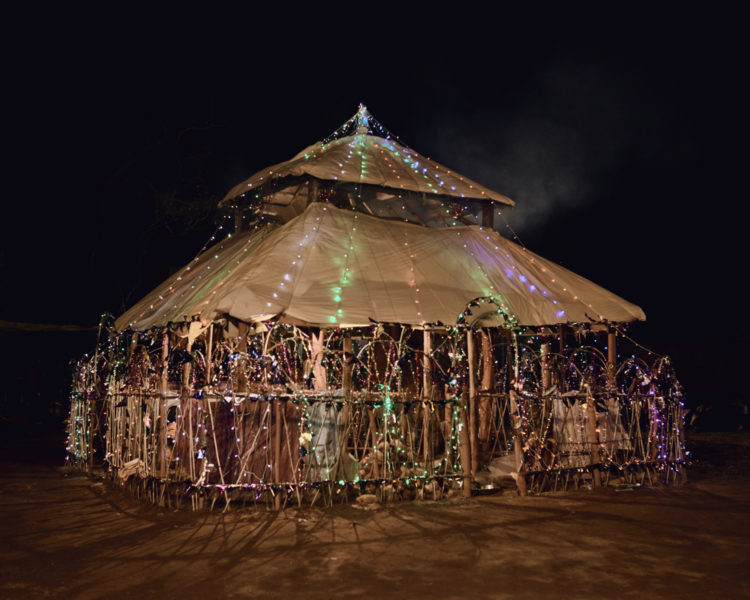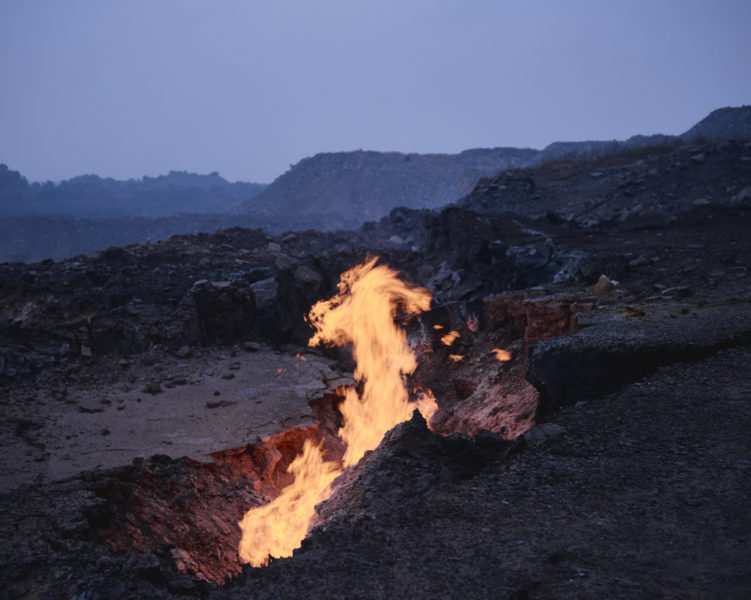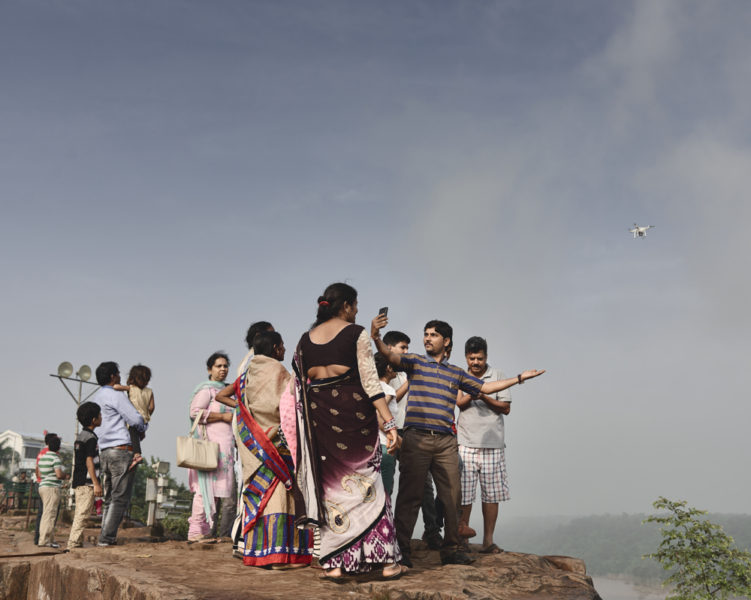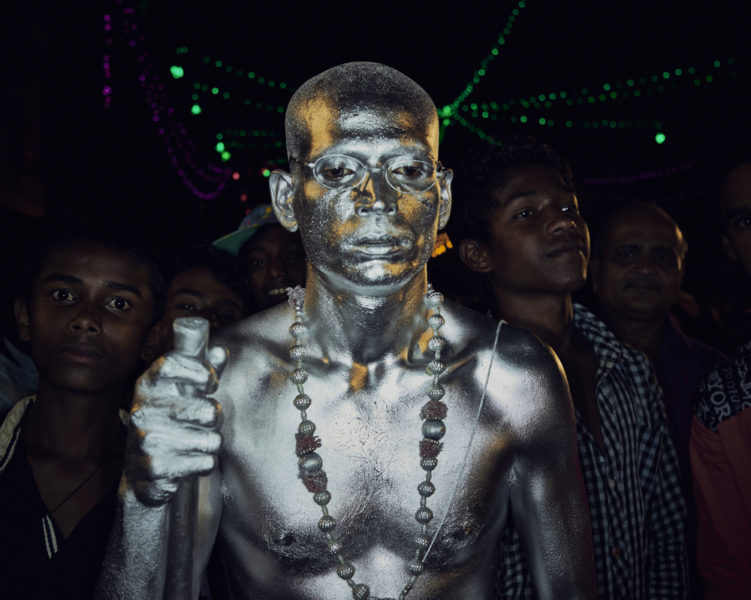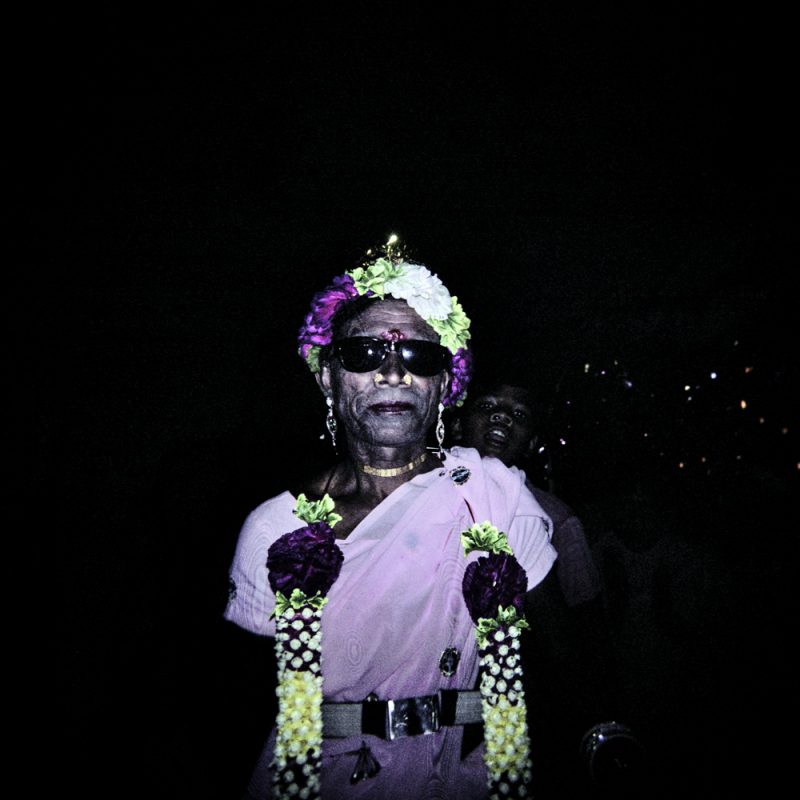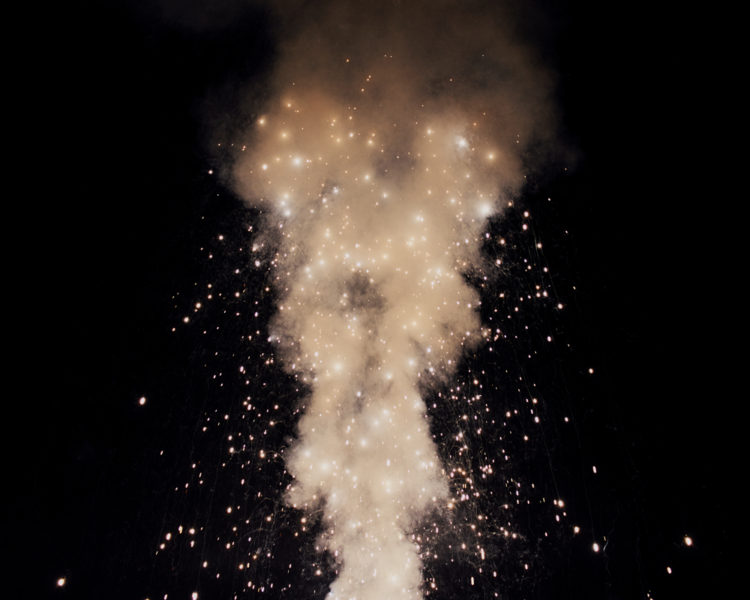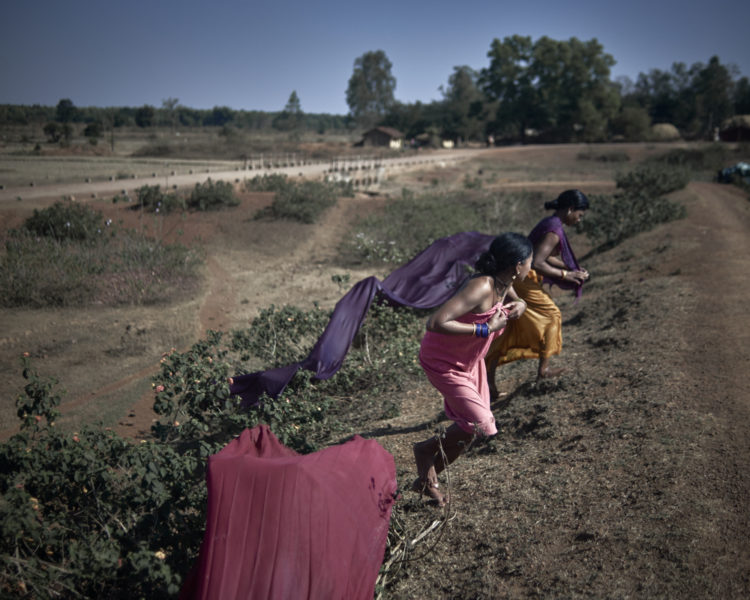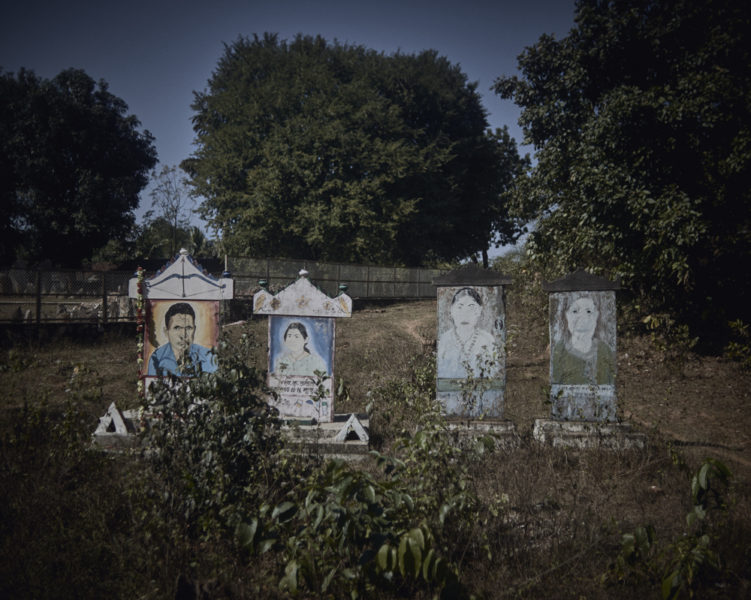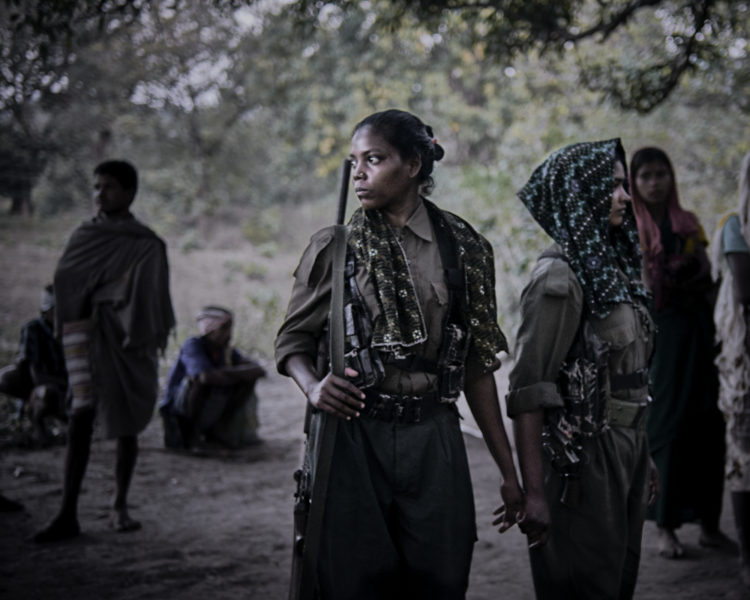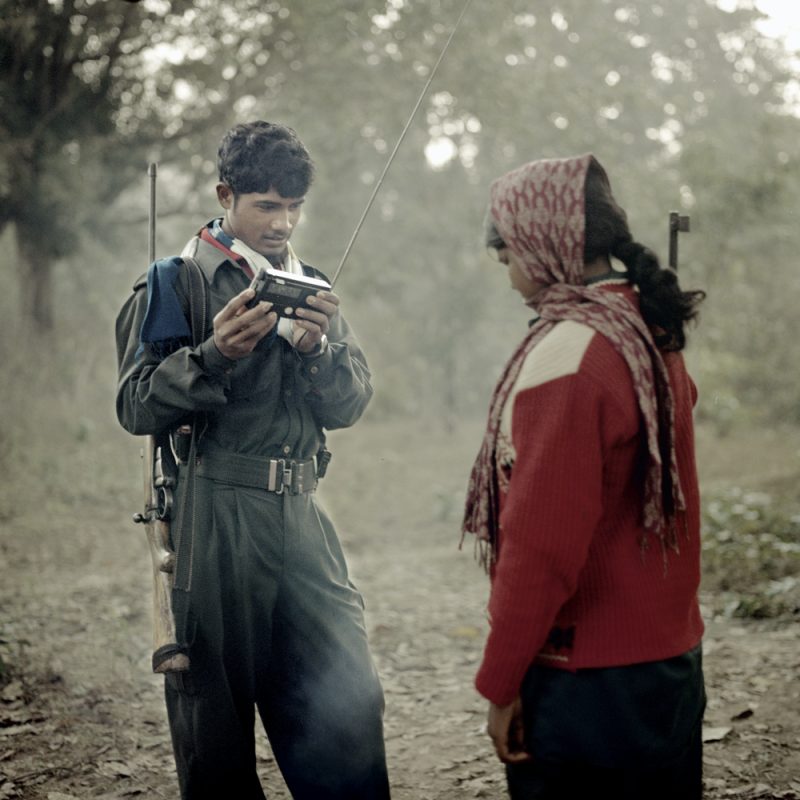Poulomi Basu
Centralia
Essay by Emilia Terracciano
Fields smoulder at night. Through a forest clearing a teenage girl walks with her rifle. Half dressed bodies lie by an upturned truck surrounded by mobile cameras. A spray-painted man poses in the guise of a metallic Gandhi at a party, perhaps in a village. Men and women gather comically for a selfie on a raised patch of land, a tiny drone hovers above them. Forests blaze. In her latest photo-documentary Centralia, Poulomi Basu presents a deranged journey that leaves one giddy, slightly sick. Often shot at night, in pitch darkness, Basu uses bright colours, high shutter speeds, low aperture and shallow depth of field, creating a centrifugal, film-like atmosphere.
Centralia takes its name from a near-ghost mining town in Pennsylvania, US. Bought up by colonial agents from native American tribes in 1749, the mineral-rich borough became a thriving mining hub up until the world war years and global depression. Declared uninhabitable in the aftermath of a subterranean fire and the spread of toxic methane gases in the 1960s, Centralia’s residents were forcibly evicted by ‘eminent domain’ in 1992. Virtually a non-place – Postal Services suspended its zip code in 2002 – the creepy municipality is mined today by horror film crews.
Basu dislocates space-time expectations, connecting the shrinkage of mining in Centralia to the expansion of these extractive activities in the global south: central and eastern India. For Basu, the collapse of this little-known US town – with its hellish sinkholes, toxic vapours, rubble homes and melting asphalt – could prefigure the destruction of the mineral-rich areas of India. Seemingly removed from the economic and political realities of Centralia, these regions are the focus of Basu’s hallucinatory reflection – one that ponders the process of corporate mining and the violence that accompanies the extraction of minerals from the soil. ‘Centralia,’ Basu writes, ‘is the future.’ Economic booms and busts of the global economy may drive Centralia but the subject of the project is the protracted war waged by the Indian military-corporate complex against tribal communities (Adivasi) over lands and natural resources. Basu exposes the violence that accompanies bipolar development narratives in India: between those who endorse the project of corporate industrialisation and those who oppose it.
Murky and complex, the portrayal of the Maoist insurgent group People’s Liberation Guerrilla Army (PLGA) divides academics, critics and artists in India. Outdated authoritarian ideologies and rigid hierarchies certainly structure the guerrilla group, whose commitment to a ‘protracted people’s war’ against the state and the enclosure of the commons has caused an escalation of violence against civilians. PLGA’s mimetic warfare strategies, following the Maoist dictum that the guerrilla must move amongst the people as fish swim in the sea, formidably pits innocent civilians against the paramilitary. The latter retaliates and destroys villages, performs extra-juridical killings, torture, rapes and arrests. Bodies are dressed up in military fatigues: identities become blurred on both sides of the divide. ‘Even if you cover this honestly, there are so many things you don’t know. The Maoists won’t tell you about them, the police always lie. The villagers don’t tell you anything. So how well can you really cover this?’ writes a local journalist interviewed by Basu.
Basu elevates obfuscation to a formal strategy, an approach that enacts a deliberate breakdown of ordinary vision and of knowledge bound to storytelling. Here, the possibility for visibility and transparency, myths that are fundamental to political and legal Euro-American discourses (and documentary photographic processes), are repeatedly questioned. Basu performs the theatrics of forensic documentary tropes on crime scenes but also inserts clues that appear to have been meddled with for and before the camera. Here the bloody, severed head of a baby goat, there the ghostly remains of a camp.
Centralia withholds the possibility for lyricism when figuring the PLGA’s armed resistance. In so doing, she does not abdicate critical questioning about insurgents’ political intentions, and the horrific consequences of their revolutionary politics for civilians. Moving through gorgeous forests, Basu resists the conventions of pastoral framing. Nature is militarised, trees offer makeshift shelters to humans and their weapons: rifles rest against trees before pujas (acts of worship) in eerie surroundings. Basu dislikes the term ‘embedded’ to describe her personal engagement with the guerrilla groups over the years. She prefers the term ‘immersed’. For sure, Basu has enjoyed the protection of Maoist units in gaining privileged access to inaccessible conflict zones but refrains from identifying with the insurgents. Intimacy and proximity are not available to her and she remains a stranger amongst these unlikely, camouflaged comrades. Such distance can be gleaned in the way she includes yellowing, gimmicky images that appear static and calmly classical in their staging. Basu, who has devoted her career to documenting the resilience of women (To Conquer Her Land, A Ritual of Exile and Isis Mothers), does share with us the militancy of PLGA’s women. She includes pixelated mugshots of deceased militant female martyrs as well as portraits of women in uniforms bearing old rifles. Such an approach suggests empathy for a way of life that resonates with Italian-American feminist Silvia Federici’s understanding of ‘a joyful militancy.’ This account of female resistance can resonate with more historically iconic examples: think of Vietnam or the Sandinista guerrilla fighters in Nicaragua. Women did play significant roles in these guerrilla fights, operating in jungles against powerful imperialist powers; social revolution was a genuine possibility and armed conflict no mere defensive strategy. It is difficult to gauge the extent to which Basu may identify with her characters. A strong sense of sympathy transpires from her shots but only a brittle heroism can be sensed. Male and female comrades appear fragmented in the fight, perhaps isolated. Moreover, it is the men who handle whatever primitive technology is available, for example, a radio. Basu limits camaraderie and its idealisation to one shot of a man and his dog.
Open-ended, Centralia offers a nightmare account of an ongoing war. Basu ultimately offers no release from this nightmare and opens up her lenses to the shelter of the night sky. ♦
All images courtesy of the artist. © Poulomi Basu
–
Emilia Terracciano is an academic and writer based in London and Oxford. She is a postdoctoral Leverhulme Fellow at Ruskin School of Art, Oxford, where she teaches the course Globalisation, Photography and the Documentary Turn. Her research interests lie in modern visual art and photographic practices with a focus on the Global South. Her book Art and Emergency: Modernism in Twentieth-Century India was published by I.B. Tauris in 2017. Terracciano also writes for The Caravan, Modern Painters and Frieze.

